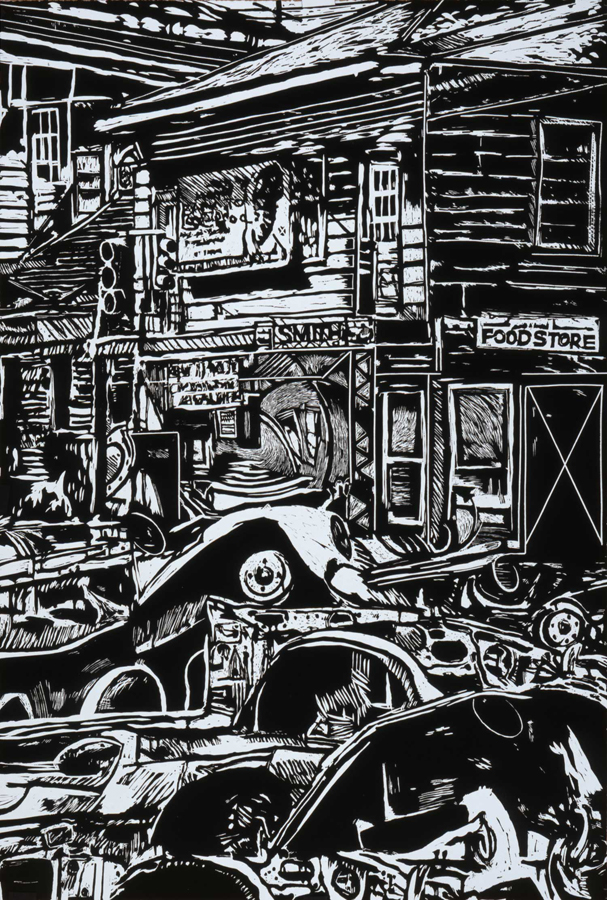Two shows at Arthur Roger Gallery run through Sept. 23
By D. Eric Bookhardt via bestofneworleans.com
 “This is the only city I have ever been in where, if you listen, the sidewalks will speak to you.” So said John T. Scott, the late gentle giant of the New Orleans art world. A son of the lower 9th Ward who spent decades on the Xavier University fine arts faculty, Scott distilled the varied sonorities of the streets into works that, like his city, encompassed both the gritty and the sublime. Sacred Music for Sonny Stitt is all poise and grace as a pair of kinetic metal sculptures comprised of delicately balanced circles and rods seem to ceremonially greet each other. Painted in the bold colors and patterns of traditional sub-Saharan fabrics, they evoke the African ideal of Ashe — the commanding inner coolness Scott associated with great musical savants like its modern jazz saxophonist namesake. Foodstore (pictured) is a 2003 woodcut of ramshackle shops on a street strewn with wreckage. A visual parable of chaos and neglect, it fuses expressionistic grit with mute echoes of troubled jazz pioneer Buddy Bolden’s shrieking cornet. For Scott, that alternation of the chaotic and the sublime was the yin and yang of what he called “jazz thinking,” the improvisation method of his creative process. Here, the way Foodstore anticipated Hurricane Katrina’s tumultuous fury was nothing short of prophetic.
“This is the only city I have ever been in where, if you listen, the sidewalks will speak to you.” So said John T. Scott, the late gentle giant of the New Orleans art world. A son of the lower 9th Ward who spent decades on the Xavier University fine arts faculty, Scott distilled the varied sonorities of the streets into works that, like his city, encompassed both the gritty and the sublime. Sacred Music for Sonny Stitt is all poise and grace as a pair of kinetic metal sculptures comprised of delicately balanced circles and rods seem to ceremonially greet each other. Painted in the bold colors and patterns of traditional sub-Saharan fabrics, they evoke the African ideal of Ashe — the commanding inner coolness Scott associated with great musical savants like its modern jazz saxophonist namesake. Foodstore (pictured) is a 2003 woodcut of ramshackle shops on a street strewn with wreckage. A visual parable of chaos and neglect, it fuses expressionistic grit with mute echoes of troubled jazz pioneer Buddy Bolden’s shrieking cornet. For Scott, that alternation of the chaotic and the sublime was the yin and yang of what he called “jazz thinking,” the improvisation method of his creative process. Here, the way Foodstore anticipated Hurricane Katrina’s tumultuous fury was nothing short of prophetic.
Dapper Bruce Lafitte was born Bruce Davenport Jr. but assumed the name of the housing project where he grew up. A self-taught artist who began drawing as a 5-year-old, he created hieroglyphiclike depictions of high school marching bands in response to the ominous quiet of New Orleans’ deserted post-Katrina neighborhoods. As street life returned, his obsessive bird’s-eye views morphed into complex, quiltlike compositions of streets, parks and byways populated by Mardi Gras Indians and colorful indigenous figures. Laced with scribbled social critiques and self-praise, his eloquently pithy works are now internationally exhibited and represented in major art collections.
